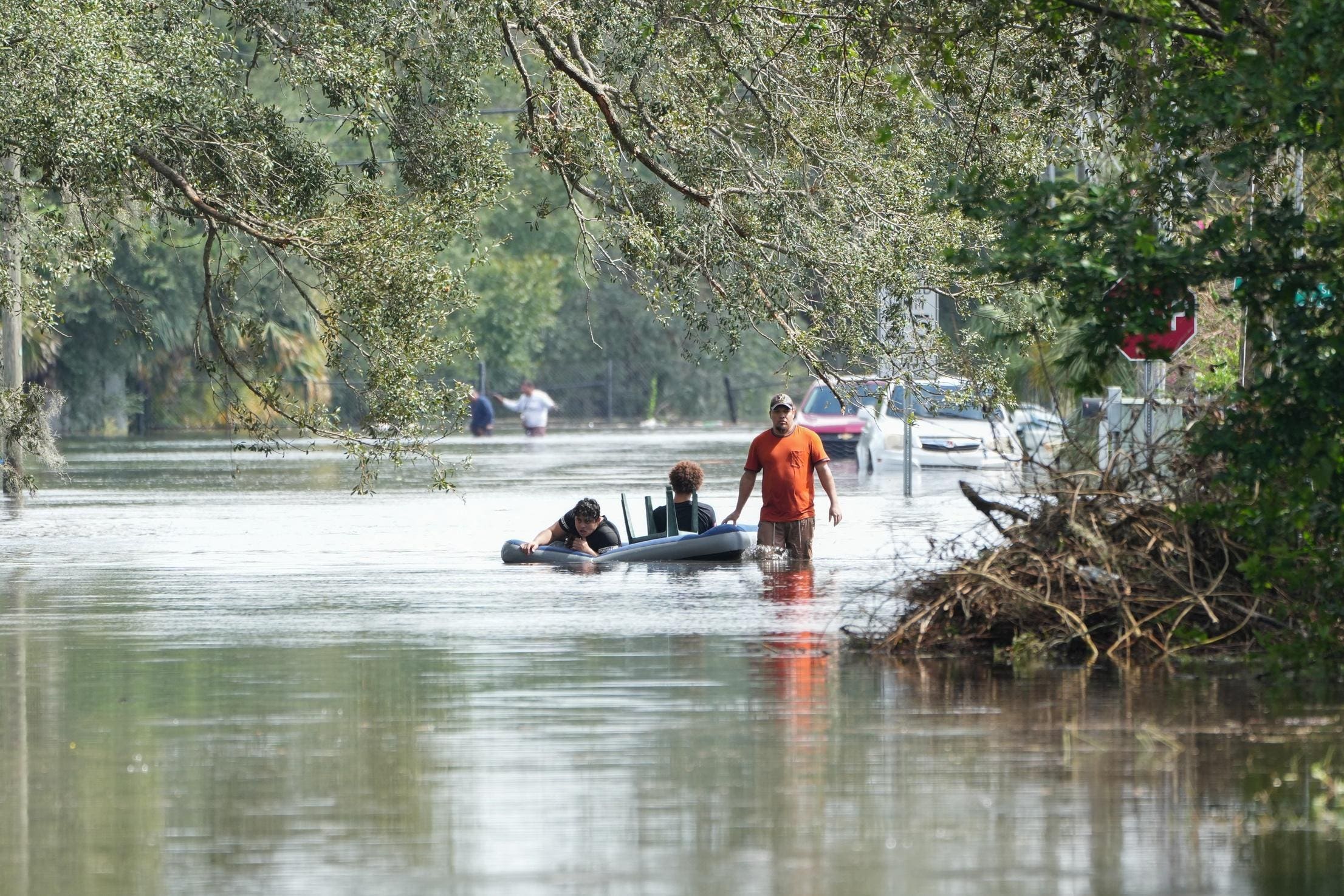Misinformation And Conspiracy Theories Hamper Hurricane Relief

Current Climate brings you the latest news about the business of sustainability every Monday. Sign up to get it in your inbox.
It’s been a terrible week for extreme weather with Hurricane Helene wreaking devastation on North Carolina and Hurricane Milton slamming into Florida. Making matters worse: Misinformation, conspiracy theories and false claims that hamper hurricane responders’ ability to operate and discourage survivors from seeking help.
“It is absolutely the worst I have ever seen,” Deanne Criswell, the head of the Federal Emergency Management Agency, or FEMA, said on Tuesday. “It’s creating distrust in the federal government, but also the state government, and we have so many first responders that have been working to go out and help these communities.”
Criswell told reporters that she had anticipated some misinformation, “but not the extent that we’re seeing.” The federal agency has long had a rumor control page to combat the scams that typically flourish after a natural disaster.
Many of the false statements can be traced to Donald Trump, the Republican presidential nominee, who has falsely accused federal responders of diverting disaster relief money to house undocumented migrants. Elon Musk, the billionaire Tesla founder and Trump supporter, has amplified false claims on Twitter to his more than 200 million followers.
Disinformation has been particularly rampant in Georgia and North Carolina, according to the New York Times. Soon after a public meeting in western North Carolina’s Rutherford County to talk about the damage and ongoing search-and-rescue efforts, for example, a conspiracy theory spread online that it included secret discussions about bulldozing, confiscating or selling land for a profit or to mine lithium.
As lies have swirled, FEMA has faced false claims that it is stealing donations or diverting disaster aid to Ukraine. For residents in storm-affected areas, already dealing with limited power and cell service, the misinformation makes it harder to know what to do to stay safe.
“It’s un-American, it really is,” President Biden said at an event on Tuesday. “People are scared to death, people know that lives are at stake.”
The Big Read
A burned ocean container with damaged lithium-ion batteries is shipped to Redwood Materials’ processing plant in Nevada.
Redwood Materials
Recycling EV Batteries Damaged By Fire And Hurricanes
Redwood Materials, a battery recycling and components maker created by Tesla cofounder JB Straubel, has added electric vehicle packs that have been damaged by fires and floods to the range of products it’s recovering to reuse the high-value metals contained within to make new lithium-ion cells.
“With batteries proliferating in cars and homes and on the grid and everywhere else, it doesn’t have to be an environmental mess at their end of life or in a disaster or a flood or whatever it might be,” Straubel told Forbes. “There are some good solutions to recover that material and make sure it doesn’t impact the environment any more than the natural disaster did in the first place.”
The Carson City, Nevada-based company has focused mainly on recycling battery packs and scrap materials from auto dealers, electronic waste recyclers and companies such as Panasonic that produce cells. But there’s a growing need to deal with batteries damaged by natural disasters. Redwood was called in by the U.S. Environmental Protection Agency to assist with the recovery of burned EV packs after a wildfire devastated Lahaina, Maui, last year and recently worked to remove and recycle battery packs being hauled in a truck that crashed and burned in California in July. The company said it’s monitoring damage in the Southeast caused by Hurricane Helene, and what could happen in Florida from Hurricane Milton. It’s prepared to help recover storm-damaged vehicle batteries there but is waiting until initial rescue and cleanup operations are complete.
Hot Topic
Lego’s Annette Stube
Bo Brinch
How do you take this product that people know and love, and is made of plastic, and make it more sustainable?
That is what I am spending my time on—making the bricks more sustainable and making sure they don’t go to waste at the end of life. The Lego brick is more than 60 years old. It requires precision that is less than the breadth of a hair. Kids are taking them into their mouths, parents are stepping on them. They need to be washable and sustain the sun and all these things that are in our lives. We have a long list of quality requirements to make this brick so it is not just falling apart. That limits the possibilities we have to make it more sustainable. It makes it harder. We are not giving up of course.
We haven’t found one material that can solve for that yet. But we have made more than 600 tests and tried many materials out. Some of them have failed. Some are being used today. There are plant parts [Lego’s trees and bushes] that are made out of plants, of sugar cane. That was one of the tests we did. It works for these softer items. But it doesn’t work for the bricks. It’s too soft. The plants should bend, but not the bricks.
What else came out of the tests?
Another one is the artificial marble kitchen tabletops. We can recycle that and use it to make it into the sabers or light swords. We are looking for all these different solutions. It’s not just one material that will fix it all to make the brick more sustainable.
While we are looking into this we are still producing this brick. We don’t want to sit on our hands until we have that solution. So we are using the principle of mass balance. We are buying certificates where our suppliers of resin add sustainable materials – now it is a biomaterial – to replace the virgin fossil fuel. We cannot attribute it to a single brick because it comes into this mixer of resin and goes out to their different customers. But we know that we have bought the certificates at a significant extra cost so that the virgin fossil fuel has been replaced.
Last year, we bought mass balance certificates for 18% of the production, which translates to 12% sustainable materials. With our half-year results, we were up to 30% production and 22% sustainable materials.
You had also tried using recycled PET plastic for the bricks. What happened with that?
The carbon footprint was larger than if we used conventional. The production process was more cumbersome so it didn’t make any sense. It was a nice story to tell. Everyone would understand Lego bricks made out of plastic bottles. Sometimes you fail and you should be open about it because otherwise how can you learn from each other? It’s not comfortable, but it is important to do that. The reality of innovation and sustainable development is that it’s difficult. If we only talk about the little successes and the little pilots we do, we are not depicting the reality of things. Because it is difficult. There are a lot of trials that go into it and a lot of failures, but we are all the time learning, and it’s all about learning.
Is recycling still a possibility?
We are starting to design for recycling. We are looking at the entire life cycle of a brick.
People keep the bricks for the next generation. A lot of people have bricks lying in their attics. We want to keep the bricks in play. We are testing different measures in the U.S., U.K. and Germany now.
If we are going to succeed, we have to make it easy for the consumer to give back these bricks. We are testing what would be most convenient. Do you want to print a label at home and send it off to us? Or bring it to your local Target store or a Lego store? Do you want to donate it? Do you want money back? Or do you want to swap it for a voucher to get new Lego bricks? All these things we are testing. It is turning out to be a popular thing. We have gotten 309 million bricks back over the past three years just in the Americas.
What we are doing now is to sort them manually. When people bring back Lego bricks, it will be not just bricks but all sorts of other stuff as well. There will be drawings and chewing gum. If we give this to other kids, it has to be 100% safe. So we are doing a lot of tests these days using AI and other high-tech technology to find out how we can sort this in an effective way to give us safe bricks. This is needed to scale those efforts. Otherwise, we will stay at the pilot level and we need to scale this.
What Else We’re Reading
John Kerry joins Tom Steyer fund making push into green investment
Hurricane Helene knocked out a key facility for monitoring the global climate
In a first, a gas utility is sued over global warming deception
A London lawsuit could amp up environmental pressure on big business
Helene recovery complicated by lies, hoaxes and conspiracy theories
Biden sets a 10-year deadline for U.S. cities to replace lead pipes and make drinking water safer
Green roofs and solar chimneys are here – experts say it’s time to use them
Why Alphabet’s clean energy moonshot depends on AI
Renewable energy installations are scaling rapidly, but not fast enough to meet 2030 targets
The leading Senate candidate in hurricane-battered Flordia banned using the words “climate change” in official documents when he was governor
When the hurricane relief worker turns out to be a neo-Nazi
For More Sustainability Coverage, Click Here.


